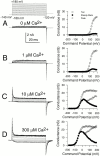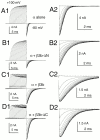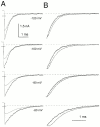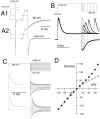Inactivation of BK channels mediated by the NH(2) terminus of the beta3b auxiliary subunit involves a two-step mechanism: possible separation of binding and blockade
- PMID: 11382808
- PMCID: PMC2232400
- DOI: 10.1085/jgp.117.6.583
Inactivation of BK channels mediated by the NH(2) terminus of the beta3b auxiliary subunit involves a two-step mechanism: possible separation of binding and blockade
Abstract
A family of auxiliary beta subunits coassemble with Slo alpha subunit to form Ca(2)+-regulated, voltage-activated BK-type K(+) channels. The beta subunits play an important role in regulating the functional properties of the resulting channel protein, including apparent Ca(2)+ dependence and inactivation. The beta3b auxiliary subunit, when coexpressed with the Slo alpha subunit, results in a particularly rapid ( approximately 1 ms), but incomplete inactivation, mediated by the cytosolic NH(2) terminus of the beta3b subunit (Xia et al. 2000). Here, we evaluate whether a simple block of the open channel by the NH(2)-terminal domain accounts for the inactivation mechanism. Analysis of the onset of block, recovery from block, time-dependent changes in the shape of instantaneous current-voltage curves, and properties of deactivation tails suggest that a simple, one step blocking reaction is insufficient to explain the observed currents. Rather, blockade can be largely accounted for by a two-step blocking mechanism (C(n) <---> O(n) <---> O(*)(n) <---> I(n)) in which preblocked open states (O*(n)) precede blocked states (I(n)). The transitions between O* and I are exceedingly rapid accounting for an almost instantaneous block or unblock of open channels observed with changes in potential. However, the macroscopic current relaxations are determined primarily by slower transitions between O and O*. We propose that the O to O* transition corresponds to binding of the NH(2)-terminal inactivation domain to a receptor site. Blockade of current subsequently reflects either additional movement of the NH(2)-terminal domain into a position that hinders ion permeation or a gating transition to a closed state induced by binding of the NH(2) terminus.
Figures
























Similar articles
-
Gating properties conferred on BK channels by the beta3b auxiliary subunit in the absence of its NH(2)- and COOH termini.J Gen Physiol. 2001 Jun;117(6):607-28. doi: 10.1085/jgp.117.6.607. J Gen Physiol. 2001. PMID: 11382809 Free PMC article.
-
Functional effects of auxiliary beta4-subunit on rat large-conductance Ca(2+)-activated K(+) channel.Biophys J. 2004 May;86(5):2871-82. doi: 10.1016/S0006-3495(04)74339-8. Biophys J. 2004. PMID: 15111404 Free PMC article.
-
Molecular basis for the inactivation of Ca2+- and voltage-dependent BK channels in adrenal chromaffin cells and rat insulinoma tumor cells.J Neurosci. 1999 Jul 1;19(13):5255-64. doi: 10.1523/JNEUROSCI.19-13-05255.1999. J Neurosci. 1999. PMID: 10377337 Free PMC article.
-
Calcium-activated potassium channels in adrenal chromaffin cells.Ion Channels. 1996;4:261-301. doi: 10.1007/978-1-4899-1775-1_7. Ion Channels. 1996. PMID: 8744211 Review.
-
Inactivation of voltage-gated cardiac K+ channels.Circ Res. 1998 Apr 20;82(7):739-50. doi: 10.1161/01.res.82.7.739. Circ Res. 1998. PMID: 9562433 Review.
Cited by
-
Divalent cation sensitivity of BK channel activation supports the existence of three distinct binding sites.J Gen Physiol. 2005 Mar;125(3):273-86. doi: 10.1085/jgp.200409239. J Gen Physiol. 2005. PMID: 15738049 Free PMC article.
-
N-terminal inactivation domains of beta subunits are protected from trypsin digestion by binding within the antechamber of BK channels.J Gen Physiol. 2009 Mar;133(3):263-82. doi: 10.1085/jgp.200810079. J Gen Physiol. 2009. PMID: 19237592 Free PMC article.
-
Reconstruction of Cell Surface Densities of Ion Pumps, Exchangers, and Channels from mRNA Expression, Conductance Kinetics, Whole-Cell Calcium, and Current-Clamp Voltage Recordings, with an Application to Human Uterine Smooth Muscle Cells.PLoS Comput Biol. 2016 Apr 22;12(4):e1004828. doi: 10.1371/journal.pcbi.1004828. eCollection 2016 Apr. PLoS Comput Biol. 2016. PMID: 27105427 Free PMC article.
-
Inactivation of BK channels by the NH2 terminus of the beta2 auxiliary subunit: an essential role of a terminal peptide segment of three hydrophobic residues.J Gen Physiol. 2003 Feb;121(2):125-48. doi: 10.1085/jgp.20028667. J Gen Physiol. 2003. PMID: 12566540 Free PMC article.
-
Species-specific Differences among KCNMB3 BK beta3 auxiliary subunits: some beta3 N-terminal variants may be primate-specific subunits.J Gen Physiol. 2008 Jul;132(1):115-29. doi: 10.1085/jgp.200809969. J Gen Physiol. 2008. PMID: 18591419 Free PMC article.
References
Publication types
MeSH terms
Substances
Grants and funding
LinkOut - more resources
Full Text Sources
Molecular Biology Databases
Miscellaneous

